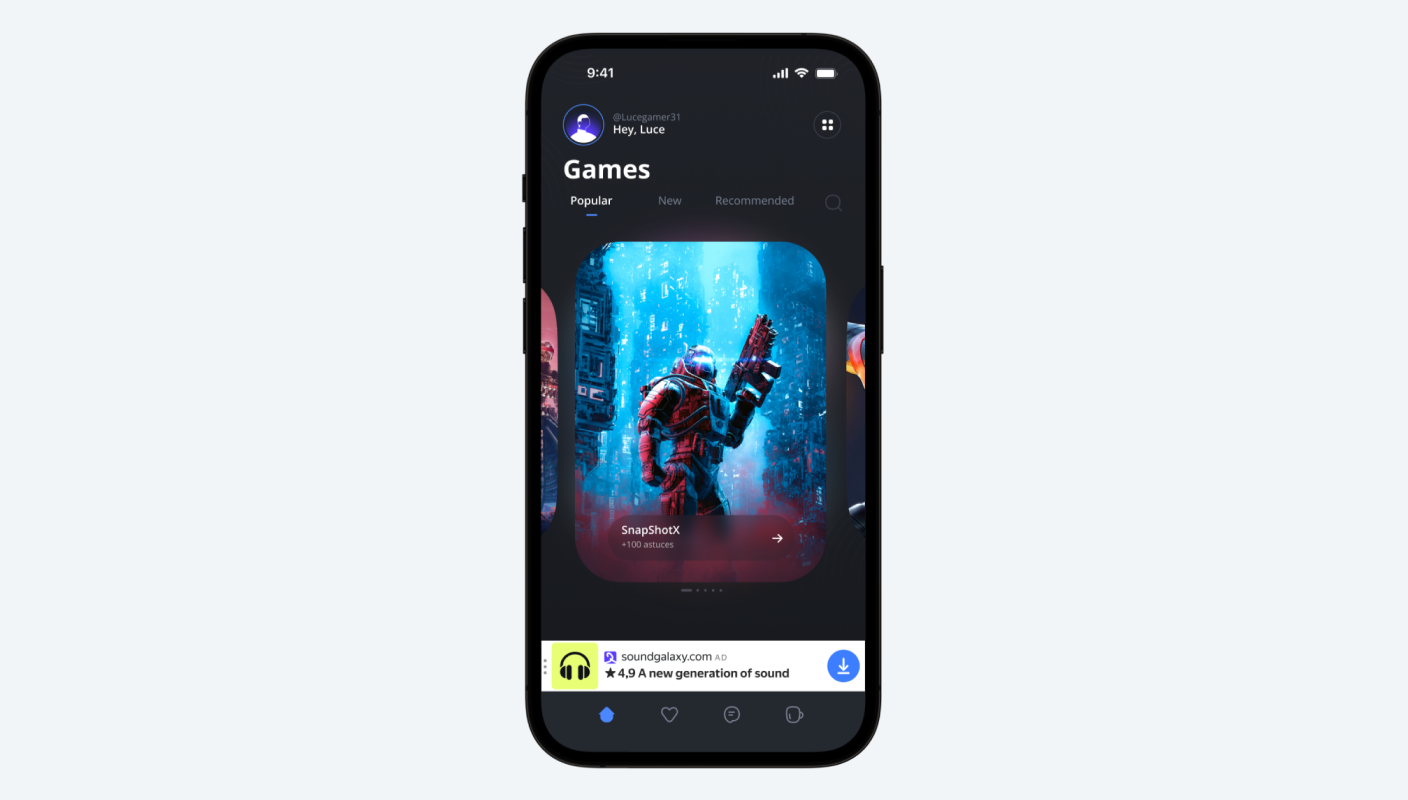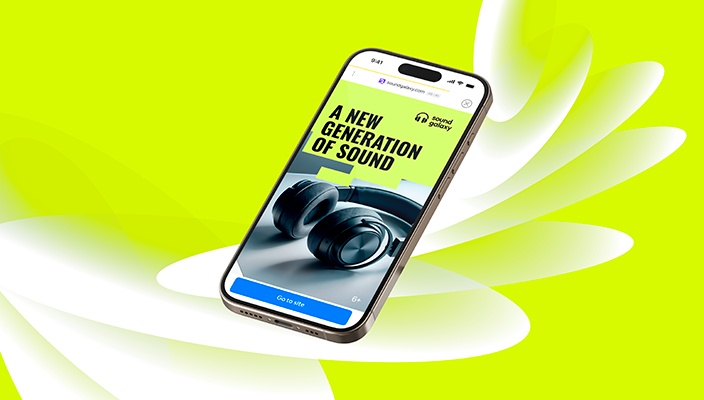In-game app advertising: Benefits, strategies, and top examples


What is in-game app advertising and how does it work?
In-game advertising is a revenue strategy in which mobile app developers place ads within the gaming experience, generating income without charging players upfront. In-game ads integrate into the game world itself — appearing as virtual billboards in racing games, sponsored items in character inventories, or branded elements within the game environment.
How does it all work? Gaming ads come in various formats, like short videos that unlock rewards, static displays integrated into menus, or interactive elements that offer in-game benefits like extra lives or power-ups. The key principle is to make ads feel relevant and natural, not disruptive. When done well, players enjoy engaging with ads because they enhance, rather than interrupt, their gaming experience.
This is a revenue opportunity that’s only growing. Global digital advertising spend reached $1.1 trillion in 2024, up 7.3% from the previous year. In-game advertising represents an expanding segment of this market, creating sustainable revenue while keeping games accessible to everyone.
The benefits of in-game app advertising
In-game app advertising turns every gaming session into a revenue opportunity. Instead of hoping a small percentage of users will buy something, you earn from most of your players through well-placed ads that feel natural within the game flow.
Here’s what makes in-game app advertising work:
- Revenue from both spenders and non-spenders — The majority of players never buy anything, but they will interact with ads if they offer value. This means you monetize beyond just the 1–5% who typically make purchases.
- Multiple earning moments per session — Players encounter different ad formats as they play, like rewarded videos for extra lives, interstitials between levels, and native ads in menus. Each interaction generates income.
- No upfront barriers — Unlike paid downloads that scare users away, or subscriptions that demand commitment, in-game ads keep your game free for users while still paying your bills.
- You control the experience — Adjust frequency, timing, and placement based on what works. Some games thrive with optional rewarded ads; others benefit from interstitials during natural breaks.
- Players stay longer — When ads provide real value like bonus coins or power-ups, users engage more and play longer. Higher retention means more ad impressions and better revenue over time.
The key is balance. Done right, ads enhance the experience rather than interrupt it, giving players value while generating revenue for you.

Ready to turn your game into a revenue opportunity?
In-game advertising formats
To increase revenue from your engaged player base, you can choose from several effective in-game advertising formats. Each format offers unique ways to generate income while maintaining player engagement and minimizing disruption to gameplay.
Interstitial ads

Interstitial ads are full-screen, immersive ad formats that appear during natural pauses in gameplay — for example, between levels or after a match. These ads grab attention with high-quality visuals, strong calls to action, and interactive features. Since they take over the entire screen, they're great for capturing attention and delivering a clear message without distractions.
The key to success with this in-game ad format is timing. Place them when players expect a pause, so they integrate smoothly into the experience. Well-placed interstitial ads can boost your earnings without disrupting player experience, making them ideal for games with clear session breaks.
Banner ads

Banner ads are compact rectangles that sit at the edges of your screen — top, bottom, or sometimes tucked into corners. Unlike interstitials or pop-ups, they don’t interrupt or demand immediate attention. They simply exist alongside your game content, staying visible throughout gameplay sessions.
The approach is straightforward: players know exactly what to expect with this ad format. Some will glance at banners, others will ignore them, but either way, they’re generating impressions. Banner ads work well when you have consistent screen space that won't interfere with core gameplay mechanics or critical user interface elements.
App open ads

Ever notice that split second when you return to an app? That brief moment between tapping the icon and seeing your game world load? App open ads live in that space. Every time you switch back to your game — from checking messages, answering calls, or just browsing your phone — you encounter a full-screen ad during the natural resume process.
It's timing that makes this format work. Players aren't mid-level or focused on gameplay when these ads appear. They're in transition mode, already expecting that slight pause as the app comes back to life. The ad feels less like an interruption and more like part of the loading experience — which, in many ways, it is
Feed ads

Feed ads appear as scrollable streams featuring a sequence of integrated ads. They nestle into areas where players are already browsing — leaderboards, achievement lists, social feeds, news sections — and mix in with regular content. As players scroll through these areas, ads blend into the existing interface design.
This format works best in games with social features or content discovery sections. Players are already in browsing mode, scrolling through information at their own pace. Feed ads turn that natural scrolling behavior into advertising opportunities without disrupting the expected user flow or breaking the interface rhythm.
Rewarded video ads

Rewarded video ads give players something they want, like in-game currency, extra lives, or bonus levels, in exchange for watching a short, full-screen video. Since users choose to engage, the ad feels more like a fair trade than an interruption. This format is popular in mobile games like Subway Surfer, where daily rewards keep players coming back.
Rewarded ads not only improve user retention, but they also drive ad revenue and increase the chance of in-app purchases. For best results, the rewards should feel meaningful, and the video should play smoothly for a satisfying, low-friction user experience.
How are in-game ads served?
If you're building free-to-play mobile games, in-game advertising is one of the easiest ways to start earning revenue without charging users. The best part is that you don't need to handle the complex stuff yourself — ad networks are there for you.
Here's how it works. As a publisher, you connect your app to an ad network by adding a lightweight software development kit (SDK). From there, the ad network handles everything, like choosing which ads to show, making sure the ads load smoothly, managing payments, and filling every possible ad slot to maximize your revenue.
The network delivers in-game ad campaigns that match your players and fit right into your game world. Whether it's a rewarded video, a native banner, or another ad format, in-game advertising appears at the right moments to keep players engaged and not annoyed.
This setup lets you focus on building great mobile games while the network takes care of monetization.

If you are looking to scale, explore Ad Network by Yango Ads
Mobile in-game advertising strategy
Creating effective in-game ads for mobile games takes more than just plugging in a few banners or video ads. With today's competitive mobile landscape and diverse player audience, developers and marketers need a solid strategy to make the most of in-game advertising campaigns. Let's take a look at key strategic points to help you build ad experiences that feel native to your game and perform well in the real world.
Know your gaming audience
Understanding your players changes how you approach monetization. Casual gamers checking in for quick sessions respond differently than hardcore players spending hours in-game.
Your analytics will show which formats fit best. Short-session players often like rewarded videos that extend playtime, while long-session players tend to tolerate banners but want interstitials only at natural breaks. Social players engage with feed ads, while solo players prefer rewards that boost individual progress.
The gaming audience just keeps expanding. Mobile gaming accounts for nearly 50% of the entire gaming industry's revenue, with over 2.9 billion mobile gamers worldwide. In the United States, 55% of mobile gaming app users are female.
These numbers challenge common assumptions about who plays mobile games. The key is matching your ad strategy to actual player behavior, rather than stereotypes about your audience.
Pay attention to ad placement
In-game ads only work when they don't ruin the fun. The golden rule? Ads should feel like a natural part of the game content, not a roadblock. Smart placement, like during loading screens or between levels, keeps the experience smooth and engaging. Whether you're using banners or dynamic in-game advertising, make sure every ad appears at the right time, in the right spot.
There are three optimal, non-invasive moments for ad placement: before gameplay begins, during natural pauses, and after gameplay ends. These are moments when players are already waiting or transitioning. During these times they are usually more open to viewing ads without feeling interrupted.
Measure and optimize
You can't improve something you aren’t tracking. Monitor key metrics like eCPM, revenue, ARPU, and LTV from your ads. Segmenting users and checking retention rates helps you deliver ads that players actually enjoy.
Rewarded ads often perform well because they keep players happier and more engaged, which translates to better revenue over time. Track custom events around ad interactions — like video completion rates, reward claim frequency, or post-ad retention — to see which placements work best. Regular measurement and adjustment based on player feedback can steadily improve your monetization.

This is where tools like App Analytics by Yango Ads come in
You get a clear view of eCPM rates, revenue trends, custom event data, and user behavior patterns, which allows you to make smarter decisions and fine-tune your strategy. With the right insights, you can optimize your revenue streams, test new ad types, and continuously improve the player experience to boost overall results.
Challenges of in-game advertising
In-game advertising can be a powerful revenue tool, but it's not without its challenges. Knowing what to expect can help you avoid the pitfalls and build better ad experiences for your players.
- Balancing ads with gameplay. In-game ads that interrupt the flow or feel out of place can frustrate players. Poor timing or bad placement can lead to drop-offs and lower retention.
- Ad fatigue. If players see the same ad over and over, they'll start ignoring it, or worse, get annoyed. Rotate your ad creatives and experiment with different formats to keep things fresh.
- Technical integration. Not all games are built the same. Getting ads to run smoothly across different devices and setups can take some work. It's important to choose an ad network that offers strong support and a lightweight SDK.
- Measuring success. With so many formats and placements, it's not always easy to tell which ads are actually driving results. You'll need good data and the right tools to make informed decisions. Try Yango Ads Ad Network to get a clear view of performance across all your ad types.
Final thoughts
In-game advertising continues to be one of the most effective and sustainable ways to monetize as the mobile app industry keeps growing. With Statista projecting the number of mobile users will reach 7.49 billion in 2025, opportunities for game publishers and developers are only expanding. In-game ads offer a smart way to tap into this massive audience. They turn engagement into income without sacrificing player experience.
To make the most of it, developers need to focus on strategic ad placements, choose the right formats, and prioritize user-friendly experiences. In-app advertising isn't just a trend, it's a new cornerstone for mobile monetization.

Team up with a trusted experts from App Monetization by Yango Ads
FAQ
What is in-game app advertising and how does it benefit game developers?
In-game advertising is a digital advertising method where ads appear inside mobile video games. It helps app developers monetize their games while keeping them free to play. It turns user engagement into revenue.
What are the main types of in-game mobile advertising formats available today?
The in-game app advertising industry offers various formats, including rewarded video ads, interstitial ads, native banners, and playable ads. Each format offers unique ways to engage users without disrupting gameplay.
How can app developers make sure their in-game ads don't disrupt the player experience?
To avoid disrupting the user's experience, developers should place ads during natural breaks, use non-intrusive formats, and work with ad networks that support smooth, context-aware online advertising.


